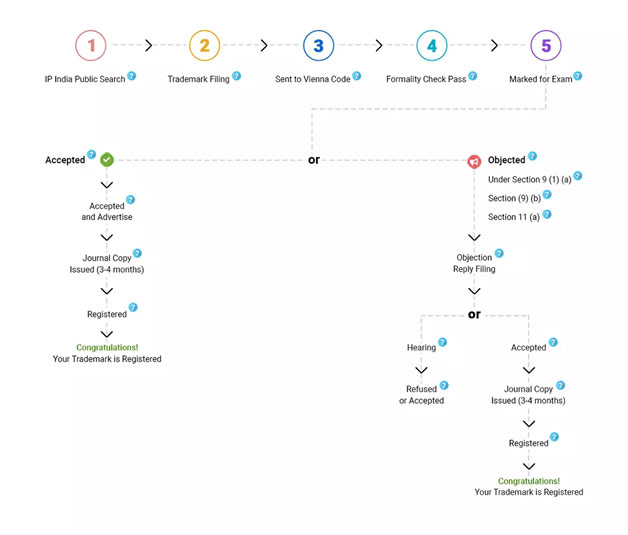- Trademark Application Acknowledgement (One TM Class)
- Brand and Logo Protection
- Power of Attorney
- Regular Status Check & Updation
- Free Customer Support


| Fill Basic Info. |
| Upload KYC Documents |
| Pay the Service Cost |
| Documents verification by us |
| Apply to Govt. Portal by us |
| Get Provisional Certificates |

Inclusive of all taxes

Trademark is an intellectual property consisting of recognizable sign or design in order to identify products or services from a specific source, although trademarks that are used to identify services are called service marks.
Yes It is very necessary to protect your brand otherwise your brand can be used and registered by another person and you have to lose the ownership of your brand.
A trademark is basically any word, name, symbol etc. which is used to identify and distinguish products or services of one specific seller or service provider from those of other competitors in the market. It also indicates the source of the products or services.
As per trademark act, all products and services are divided in 45 classes. A Trademark classification is a procedure by which examiners and the trademark attorneys arrange the required documents including trademark and service mark application, according to the description of goods to which the marks are applicable.
Once the trademark application is successful, you receive an acknowledgement providing you the right to use the TM symbol. After the registration of it, you can use the ® symbol.
Copyright
It protects original works in the form of intellectual property (literary, dramatic, musical, artistic etc.). A business can copyright its books, reports, audio or video materials.
Trademark
It protects words, names, symbols, colors etc that distinguish products and services from those of others. It indicates the source of the goods. A company can register its business name, logos, slogans, etc that creates the brand image of a company.
Patent
Government grants an exclusive right to an inventor for an invention for a limited period of time in exchange for the disclosure of the discovery to the general public.
Registered Trademarks are valid for 10 years from the date of filing the application. The trademark owner can file for renewal of the trademark to keep it protected for more time prior to the end of the validity.
Trade mark registration gives the proprietor the right to exclusive use of the mark in respect of the goods or services covered by it. Possibly the most important reason for registration of a trade mark is the powerful remedies against unauthorized use.
A registered trade mark can be hypothecated as security, meaning that a registered trade mark can be pledged as security to secure loan facilities much the same way as immovable property can be bonded.
A very important reason for registration is to create the trade mark as an identifiable intangible property in the legal sense. Trade mark registration is a value store or receptacle of the value attaching to the reputation or goodwill that the product enjoys.
A registered trade mark can be licensed. A trade mark licence can be recorded on the trade mark register, giving the licensee rights to institute legal proceedings in the event of infringement.
A registered trade mark can be transferred. The same is not possible for a common law trade mark, which can only be transferred with the business.
Trademark registration deters other traders from using trademarks that are similar or identical to yours in relation to goods and services like yours. By using the ® symbol, you put others on notice of your rights.
Trademark registration is prima facie evidence of the validity of the registration and the rights conveyed by registration. In legal proceedings relating to registered trademarks the fact that a person is registered as the proprietor of the trademark is evidence of the validity of the original registration of the trademark unless the contrary is proved.
The right to use the symbol ® or "R" or word registered